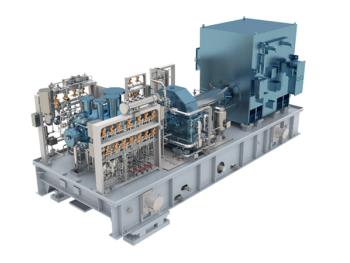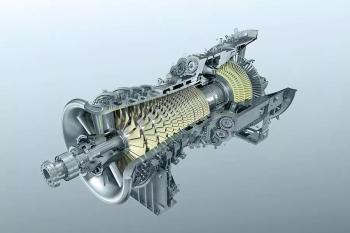
- July/August 2023
- Volume 64
- Issue 4
Gas Turbine Sales Surged in 2022
Worldwide orders of turbines were up 47%, but 2023 sales are expected to be lower.
The gas turbine business hasn’t exactly been thriving in recent years. About a decade ago, annual worldwide sales in MWs amounted to around 60 GW of new machines. However, the last five years have witnessed a market slump down to the 30-40 MW range. Things changed in 2022. Gas turbine sales rebounded to 50 MW worldwide. This is the industry’s best total in almost a decade.
LARGE-FRAME GAS TURBINE TRENDS
More than 70% of the total worldwide MW sales business came from orders of large-frame gas turbines. These include a number of models from GE (7F.05, 7H, 9F, and 9H), Mitsubishi Power (F, G, and J series), Siemens Energy (F and H series), and Ansaldo Energia (94.3A and GT36). These large-frame units each provide at least 225 MW of capacity—some provide more than 500 MW. Hence, a relatively small number of sales of large units has a major influence on the annual total.
GE traditionally dominates the large-frame gas turbine sector. However, big orders from China to Mitsubishi Power and Siemens Energy propelled both well ahead of GE in 2022. Mitsubishi Power accounted for about 33% of MW orders, Siemens Energy had 26%, GE had 18% (GE and Baker Hughes combined had a 25% share), and Ansaldo Energia comprised 10% of worldwide MW sales.
“Orders for large-frame turbines tend to be cyclic, so it is unlikely that 2023 will witness another jump in orders for these machines,” said Tony Brough, president of Dora Partners.
What tends to happen is that the major OEMs’ pendulum swings between getting contracts signed for new turbines and the manufacturing, delivery, and commissioning of those orders in power plants. One year, they may secure orders for dozens of turbines. When the order backlog lengthens, they shift focus to cranking out the turbines and getting them up and running in the field. Gone are the days when OEMs cranked out machines in the expectation that a healthy market would always be there. Due to the uncertain and ever-changing nature of the power market, they don’t want to be stranded with dozens of machines that nobody wants.
Meanwhile, restructuring continues among large turbine manufacturers. Siemens spun off Siemens Energy in 2020, which focuses on traditional power generation, renewable energy, and oil and gas. GE, too, divested itself of its GE Oil & Gas assets (now known as Baker Hughes), although the two companies share gas turbine technologies and supply chains. Mitsubishi Power has also undergone reorganization to be more tightly focused on the large gas turbine combined-cycle market.
This year, the trend continues. GE has split off its power generation assets into a new semi-independent entity called GE Vernova.
Aeroderivative gas turbines are the bright spot forunit orders. Although they were down 6% in 2022, Brough sees aeros as the healthiest segment of the gas turbine sector. Outside of Russia, where Zorya-Mashproekt and United Engine Corp. have been the only game in town for many years, GE/Baker Hughes aeroderivatives gained a 93% market share for the year.
"LM6000 and LM2500+ orders were the big contributors to the GE/Baker Hughes share,” Brough said.
Since 2017, GE’s share of this market has never fallen below 60%, and its dominance is clearly growing. The Siemens Energy acquisition of Rolls-Royce hasn’t resulted in stiffer competition to GE aeroderivative sales. In fact, the combined Siemens Energy/Rolls-Royce aeroderivative slice of the aero pie has fallen from over 40% in 2017 to zero in 2022. However, it should be noted that Siemens Energy managed over 20% market share in 2021, so a rebound
is possible.
Mitsubishi Aero recorded 7% of aeroderivative orders in 2022—its best number since 2018. The company’s acquisition of PW Power Systems a couple of years ago has yet to take a serious bite out of GE aeroderivative unit sales.
AERODERIVATIVE FLEET SIZE
Not surprisingly, GE boasts by far the biggest aeroderivative fleet. Leading the way are the LM2500 and LM2500+, with more than 2,500 units sold worldwide between them. They are followed by the LM6000 aeroderivative turbine at 1,185 units. The bulk of these machines continues to operate despite many being decades old. The first LM2500 appeared in 1969, and the first LM6000 in 1988.
Under the Siemens Energy/Rolls-Royce banner, we have the SGT-A65
(formerly the Trent 60) with 739 units sold worldwide. However, Siemens Energy has determined that this machine has reached its end of life. The Mitsubishi Aero FT8 has accumulated 547 units over the course of its lifespan. No other machine has a fleet of more than 350 units.
Looking over the long term, by far the healthiest segment of the aeroderivative space is North America. In fact, it is the only region where aeroderivative sales are up when you compare 2009–2015 to 2016–2022. Aero unit orders in North America were up more than 26% in 2022, and MW orders were 9% higher. More than three-quarters of these orders were for the LM2500+. This machine also dominated worldwide orders in 2022, followed by the LM6000.
“The expanding LNG industry continues to deploy many aeroderivative turbines,” Brough said. “But watch out for Solar Turbines’ upcoming introduction of the Titan 350 at 34–38 MWs, which is squarely aimed at the LM2500+ market.”
THE BIG PICTURE
According to the U.S Energy Information Administration (EIA), natural gas accounts for almost 40% of current electricity production, followed by nuclear (19%), coal (18%), wind (11%), hydrogen (6%), and solar power at about 5%.
Mark Axford, a consultant at Axford Turbine Consultants, expects natural gas to hold most of its ground in the coming years. The momentum of wind, solar, and BESS has slowed due to supply chain challenges impacting cost and availability. Years of confident predictions about the affordability trend of batteries, for example, have proven faulty. The price per kWh of batteries was supposed to be below $100 by now. Instead, prices have gone up over the last couple of years. Axford notes a global shortage of lithium could further affect BESS economics.
How about hydrogen-fueled gas turbines? Axford is doubtful that hydrogen will eventually replace natural gas as the fuel used in gas turbine plants. He sees two basic problems with the green-energy vision of using surplus wind and solar to produce hydrogen via electrolysis: The inefficiency of the process, and the lack of infrastructure to store and transport hydrogen.
“I don’t expect that the percentage of hydrogen blended with natural gas will ever exceed 15%, and it will probably be much lower,” Axford said.
FORECAST FOR 2023
More than a year ago, Axford forecast that gas turbine orders would be slightly down in 2022. But the market is always subject to random factors. Who would have predicted, for example, that oil would surge again above $100 a barrel (as it did in the summer of 2022), that inflation would continue above 6% per year, or that the war in Ukraine would pass the year mark? Such events cause major market disruption and tend to throw off forecasts.
Despite the lack of a crystal ball to forewarn of major disruptive events on the immediate horizon, Axford expects overall worldwide gas turbine orders to drop in 2023, perhaps by as much as 20% in MW capacity. However, he predicts that unit orders will remain largely flat.
Drew Robb, former Editor in Chief of Turbomachinery International, continues to write about technology and engineering.
Articles in this issue
over 2 years ago
Turbo Tips: Commissioning Turbomachineryover 2 years ago
Myth Busters: Dual Drives Always Work Better!over 2 years ago
Case Study: Maintenance Tips for Magnetic Drive Pumpsover 2 years ago
Turbo Tour: RMS: A Multi-OEM Repair & Maintenance Shopover 2 years ago
Repair & Maintenance Trends Necessitate Tech Innovationsover 2 years ago
The Future of Hydrogen as a Gas Turbine FuelNewsletter
Power your knowledge with the latest in turbine technology, engineering advances, and energy solutions—subscribe to Turbomachinery International today.




